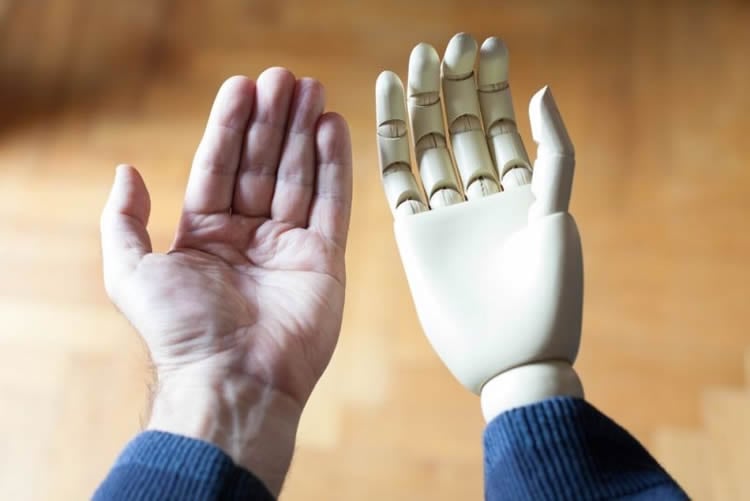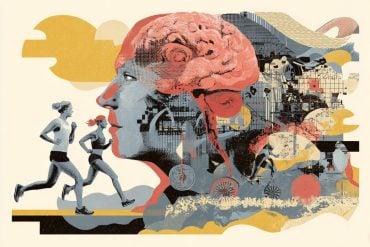Summary: A new study that utilized electronic sensors discovered prosthesis users rely more heavily on their intact limbs to perform every tasks in their daily lives.
Source: University of Salford.
Researchers from the University of Salford have used new techniques to show that people with artificial arms and hands rely heavily on their intact limbs.
In the first major study of its kind, researchers used electronic sensors to look in detail at the daily activities of a group of people with one prosthetic hand over the course of a week.
Previously, clinicians have relied on data from self-reported questionnaires completed by prosthesis users about how they use their artificial limbs, but these are often unreliable.
Their paper, published in the journal Scientific Reports, confirms a widely held belief that prosthesis users relied heavily on their intact limb in their daily lives.
Detailed and objective data
The research team leader Laurence Kenney, Professor of Rehabilitation Technologies at the University of Salford, said: “Although it has widely been suspected that prosthesis users have a tendency to rely on their intact arm, this is the first time that objective and detailed data has been produced to confirm this is the case.
“Relying too much on one limb may lead to overuse injuries, and our findings are consistent with reports that upper limb amputees are more likely to experience such problems.”
The group of prosthesis users were from a range of ages and included people who had been born without hands as well as those who had needed amputations.
Electronic sensors
Electronic sensors were placed on the wrists of both the prosthetic hand and the intact hand to measure continuous activities over seven days.

The technique gave researchers incredibly accurate data about how much they were using each of their hands, and the results were compared against a similar group of 20 people with both limbs intact.
The researchers found all of the prosthesis users showed an increased reliance on their intact hand, although they did find that those who had been using a prosthetic hand for longer did not rely on the intact hand as heavily.
They also looked at how long people were wearing their artificial hands during the day – as prostheses users sometimes choose not to wear their devices – but found there was no relationship between this and how much they relied on the intact hand.
Finally, the researchers also invited participants into the lab to study how well the prosthesis users performed on a simple pick and place task. The researchers found no relationship between measures of task performance with either the amount of time a prosthesis was worn, or the degree of reliance on the intact arm.
Professor Kenney said: “While further work is needed, our new technique allows clinicians and researchers to understand for the first time how people with prosthetic limbs actually use them in their day to day lives. This technique may eventually lead to better ways of supporting people who have been given prosthetic limbs.”
Source: University of Salford
Publisher: Organized by NeuroscienceNews.com.
Image Source: NeuroscienceNews.com image is adapted from the University of Salford news release.
Original Research: Open access research for “Upper limb activity in myoelectric prosthesis users is biased towards the intact limb and appears unrelated to goal-directed task performance” by A. Chadwell, L. Kenney, M. H. Granat, S. Thies, J. Head, A. Galpin, R. Baker & J. Kulkarni in Scientific Reports. Published July 23 2018.
doi:10.1038/s41598-018-29503-6
[cbtabs][cbtab title=”MLA”]University of Salford”New Techniques Show Prosthetics Users Rely on Intact Limb.” NeuroscienceNews. NeuroscienceNews, 26 July 2018.
<https://neurosciencenews.com/prosthetic-intact-limb-9616/>.[/cbtab][cbtab title=”APA”]University of Salford(2018, July 26). New Techniques Show Prosthetics Users Rely on Intact Limb. NeuroscienceNews. Retrieved July 26, 2018 from https://neurosciencenews.com/prosthetic-intact-limb-9616/[/cbtab][cbtab title=”Chicago”]University of Salford”New Techniques Show Prosthetics Users Rely on Intact Limb.” https://neurosciencenews.com/prosthetic-intact-limb-9616/ (accessed July 26, 2018).[/cbtab][/cbtabs]
Abstract
Upper limb activity in myoelectric prosthesis users is biased towards the intact limb and appears unrelated to goal-directed task performance
Studies of the effectiveness of prosthetic hands involve assessing user performance on functional tasks, typically collected in the lab, sometimes combined with self-report of real-world use. In this paper we compare real-world upper limb activity between a group of 20 myoelectric prosthesis users and 20 anatomically intact adults. Activity was measured from wrist-worn accelerometers over a 7-day period. The temporal patterns in upper limb activity are presented and the balance of activity between the two limbs quantified. We also evaluated the prosthesis users’ performance on a goal-directed task, characterised using measures including task success rate, completion time, gaze behaviour patterns, and kinematics (e.g. variability and patterns in hand aperture). Prosthesis users were heavily reliant on their intact limb during everyday life, in contrast to anatomically intact adults who demonstrated similar reliance on both upper limbs. There was no significant correlation between the amount of time a prosthesis was worn and reliance on the intact limb, and there was no significant correlation between either of these measures and any of the assessed kinematic and gaze-related measures of performance. We found participants who had been prescribed a prosthesis for longer to demonstrate more symmetry in their overall upper limb activity, although this was not reflected in the symmetry of unilateral limb use. With the exception of previously published case studies, this is the first report of real world upper limb activity in myoelectric prosthesis users and confirms the widely held belief that users are heavily reliant on their intact limb.






